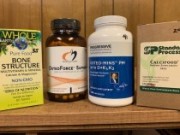Osteoporosis and the B.O.N.E.S. Protocol


Osteoporosis is a complex disorder that takes a bit of detective work to figure out how to support each individual according to their unique needs. Consultation with a practitioner like myself that takes a holistic, functional medicine approach is essential to reversing bone loss. In summary my protocol always includes: B.O.N.E.S:
Build up the gut biome and build up your body with exercise
Optimize hormones
Nourish with the right foods and supplements
Eliminate bone destroyers and
Smile!
Nutrients that Support Bone Health:
1). Adequate Calcium - It is universally known that a diet that includes adequate amounts of calcium is essential for building strong bones and teeth. The recommended daily intake (RDI) of calcium is 1,000 mg per day for most adults, however, I rarely advise individuals to take this much calcium in a supplement form, and strongly recommend food sources as the way to meet at least half of your needs. Calcium supplements that are not balanced with other minerals and vitamins can create havoc in the body, such as kidney stones or calcification of the arteries. Dairy products (milk, yogurt, cheese) are NOT the best options for calcium intake and should be minimized in the diet due to being implicated in many chronic conditions – such as allergies, sinus congestion, eczema, and autoimmune disorders. In fact a Swedish study revealed that drinking more than 1 glass of milk a day not only did nothing to alleviate risk of hip fracture in post-menopausal women, but significantly increased their risk of mortality. So as in the Blue Zone diet, consume only small amounts of raw dairy products. Chia seeds, almonds, sardines and canned salmon, kale/ mustard/ collard greens, legumes, figs and other dried fruits are sources of calcium that also include phytonutrients important for bone health. For example, kale is a powerhouse when it comes to useable calcium and it also contains Vitamin C for support of cartilage and vitamin K, which is essential to form the bone protein matrix. Some dark greens, like spinach, are high in oxalates which are known to block calcium absorption, and this must be taken into consideration depending on the individual’s unique chemistry. The correct form of calcium as a supplement is also important; some forms like calcium carbonate have very poor absorption and may contain heavy metals if they are sourced from oyster shells.
2). Adequate Vitamin D and Vitamin K – Vitamin D is essential for the body to absorb calcium from the food we eat by its direct action on the intestine. To a lesser degree Vitamin D also stimulates absorption of phosphate and magnesium ions, which are also important for bone mineralization. Sensible sun exposure is still the best way to achieve adequate levels of Vitamin D3 (the bioactive form cholecalciferol), often called the sunshine vitamin! Food sources of Vitamin D include fatty fish, cod liver oil, free-range eggs, mushrooms and liver. Vitamin K is needed to form various proteins for bone mineralization and has a regulatory effect on the bone remodeling process. There are two main kinds of vitamin K: Phylloquinone (or PK) and Menaquinones (MKn), MK-7 is a longer acting form of the vitamin and works better with Vitamin D. Since Vitamin K is also involved in the clotting cascade, it is contraindicated when taking certain blood thinners. Best sources of vitamin K include, kale, broccoli, asparagus, parsley, Brussel sprouts and even prunes. According to the data from the Harvard Nurses Study, eating one serving of dark green, leafy vegetable a day cut the risk of hip fracture in half when compared with eating one serving a week.
3). Additional Minerals and Vitamins – Many minerals and co-factors are essential to support the bone hydroxyapatite crystal formation and structure; other nutrients have indirect roles as cofactors or as regulators of cellular activity. Phosphorous and magnesium are 2 of the major foundational minerals found in bone. While phosphorous deficiency is uncommon in the US, magnesium is often lacking. Too much phosphorous, which is often consumed in sodas, can be detrimental to bones. Magnesium stimulates bone building (osteoblast activity), which improves bone microarchitecture and strength. Other important minerals for bone health include boron, copper, iron, manganese, selenium, iodine, and zinc. Strontium for bone strength remains a controversial topic since research remains inconclusive. Vitamin C as previously stated supports the building blocks for collagen, other vitamins, including vitamin A and the B vitamins, also have roles in bone maintenance.
4). Adequate Omega 3’s and Phytonutrients- A growing body of research indicates that the beneficial omega 3 fats found in fish or omega 3 supplements are supportive of bone health by improving calcium utilization, however the exact mechanism remains unclear. Phytonutrients like polyphenols, lycopene and flavonoids have been found in studies to reduce oxidative stress and promote bone building. Phytonutrients compounds are found in green tea, onions, garlic, spices, legumes, olives and in brightly colored fruits / vegetables, especially deep red / purple berries, dark greens, citrus fruits, bell peppers, broccoli, plums and tomatoes. So eat the rainbow like individuals do in the Blue Zones to protect your bones! www.bluezones.com
5). JOY – This last ingredient comes straight from the Good Book: Proverbs 17: 22
A joyful heart is good medicine, but a crushed spirit dries up the bones.

